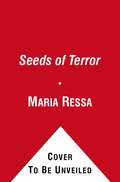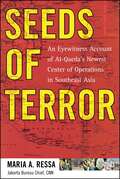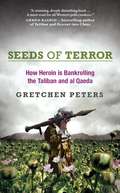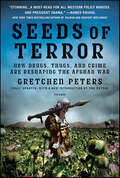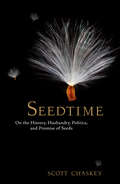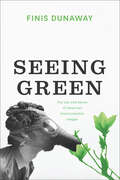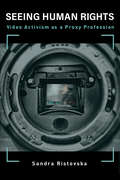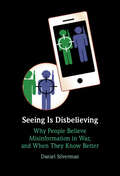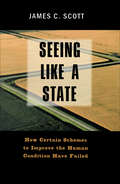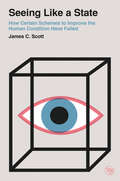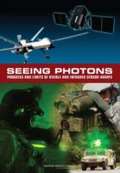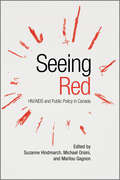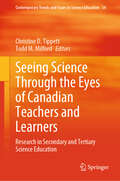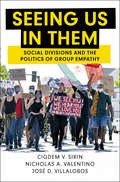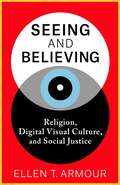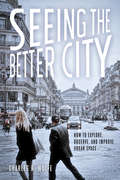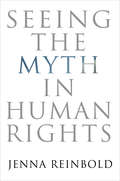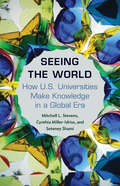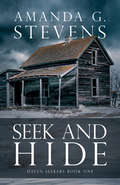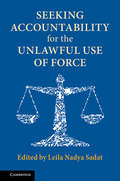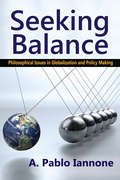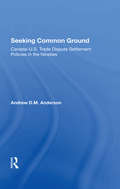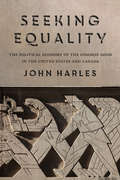- Table View
- List View
Seeds of Terror: An Eyewitness Account of Al Qaeda's Newest Center of Operations in Southeast Asia
by Maria RessaFor anyone wishing to understand the next, post-9/11 generation of al-Qaeda planning, leadership, and tactics, there is only one place to begin: Southeast Asia. In fact, such countries as the Philippines, Indonesia, Thailand, and Malaysia have been crucial nodes in the al-Qaeda network since long before the strikes on the Pentagon and World Trade Center, but when the allies overran Afghanistan, the new camps in Southeast Asia became the key training grounds for the future. It is in the Muslim strongholds in the Philippines and Indonesia that the next generation of al-Qaeda can be found. In this powerful, eye-opening work, Maria Ressa casts the most illuminating light ever on this fascinating but little-known "terrorist HQ." Every major al-Qaeda attack since 1993 has had a connection to the Philippines, and Maria Ressa, CNN's lead investigative reporter for Asia and a Filipino-American who has lived in the region since 1986, has broken story after story about them. From the early, failed attempts to assassinate Pope John Paul II and Bill Clinton to the planning of the 9/11 strikes and the "48 Hours of Terror," in which eleven American jetliners were to be blown up over the Pacific, she has interviewed the terrorists, their neighbors and families, and the investigators from six different countries who have tracked them down. After the Bali bombing, al-Qaeda's worst strike since 9/11, which killed more than two hundred, Ressa broke major revelations about how it was planned, why it was a Plan B substitute for an even more ambitious scheme aimed at Singapore, and why the suicide bomber recruited to deliver the explosives almost caused the whole plan to fall apart when he admitted he could barely drive a car. Above all, Ressa has seen how al-Qaeda's tactics are shifting under the pressures of the war on terror. Rather than depending upon its own core membership (estimated at three to four thousand at its peak), the network is now enmeshing itself in local conflicts, co-opting Muslim independence movements wherever they can be found, and helping local "revolutionaries" to fund, plan, and execute sinister attacks against their neighbors and the West. If history is any guide, al-Qaeda revisits its plans over and over until they can succeed -- and many of those plans have already been discovered and are here revealed, thanks to classified investigative documents uncovered by Ressa.
Seeds of Terror: An Eyewitness Account of Al-Qaeda's Newest Center of Operations in Southeast Asia
by Maria RessaFor anyone wishing to understand the next, post-9/11 generation of al-Qaeda planning, leadership, and tactics, there is only one place to begin: Southeast Asia. In fact, such countries as the Philippines, Indonesia, Thailand, and Malaysia have been crucial nodes in the al-Qaeda network since long before the strikes on the Pentagon and World Trade Center, but when the allies overran Afghanistan, the new camps in Southeast Asia became the key training grounds for the future. It is in the Muslim strongholds in the Philippines and Indonesia that the next generation of al-Qaeda can be found. In this powerful, eye-opening work, Maria Ressa casts the most illuminating light ever on this fascinating but little-known "terrorist HQ." Every major al-Qaeda attack since 1993 has had a connection to the Philippines, and Maria Ressa, CNN's lead investigative reporter for Asia and a Filipino-American who has lived in the region since 1986, has broken story after story about them. From the early, failed attempts to assassinate Pope John Paul II and Bill Clinton to the planning of the 9/11 strikes and the "48 Hours of Terror," in which eleven American jetliners were to be blown up over the Pacific, she has interviewed the terrorists, their neighbors and families, and the investigators from six different countries who have tracked them down. After the Bali bombing, al-Qaeda's worst strike since 9/11, which killed more than two hundred, Ressa broke major revelations about how it was planned, why it was a Plan B substitute for an even more ambitious scheme aimed at Singapore, and why the suicide bomber recruited to deliver the explosives almost caused the whole plan to fall apart when he admitted he could barely drive a car. Above all, Ressa has seen how al-Qaeda's tactics are shifting under the pressures of the war on terror. Rather than depending upon its own core membership (estimated at three to four thousand at its peak), the network is now enmeshing itself in local conflicts, co-opting Muslim independence movements wherever they can be found, and helping local "revolutionaries" to fund, plan, and execute sinister attacks against their neighbors and the West. If history is any guide, al-Qaeda revisits its plans over and over until they can succeed -- and many of those plans have already been discovered and are here revealed, thanks to classified investigative documents uncovered by Ressa.
Seeds of Terror: How Drugs, Thugs and Crime are Reshaping the Afghan War (Playaway Top Adult Picks C Ser.)
by Gretchen PetersSeeds of Terror will reshape the way you think about the West's enemies, revealing them less as ideologues and more as criminals who earn billions of pounds every year off the opium trade. With the breakneck pace of a thriller, author Gretchen Peters traces their illicit activities from the vast poppy fields of southern Afghanistan to heroin labs run by Taliban commanders, from drug convoys armed with Stinger missiles to the money launderers of Karachi and Dubai. Based on hundreds of interviews with Taliban fighters, smugglers, and law enforcement and intelligence agents, Peters makes the case that we must cut terrorists off from their drug earnings if we ever hope to beat them.
Seeds of Terror: How Drugs, Thugs, and Crime Are Reshaping the Afghan War
by Gretchen PetersSeeds of Terror is a groundbreaking triumph of reporting, a book that changed U.S. policy toward the Afghan heroin trade and the fight against terror.Gretchen Peters exposes the deepening relationship between the Taliban and drug traffickers, and traces decades of America's failure to disrupt the opium production that helps fund extremism. The Taliban earns as much as half a billion dollars annually from drugs and crime, and Peters argues that disrupting this flow of dirty money will be critical to stabilizing Afghanistan. Based on hundreds of interviews with fighters, smugglers, and government officials, Seeds of Terror is the essential story of the narco-terror nexus behind America's widening war in Afghanistan.
Seedtime: On the History, Husbandry, Politics and Promise of Seeds
by Scott ChaskeyScott Chaskey—working farmer, poet, and spiritual father of the community farming movement—considers "the web of biodiversity and resilience at the heart of our cultural inheritance" by masterfully weaving history, politics, botany, literature, mythology, and memoir into a beautiful and instructive book.It's hard to think of a subject more fundamental to the sustenance of the human race than seeds. Having coevolved with the Earth's plants, insects, and animals, seeds are entwined with the core myths of ancient cultures and the development of human consciousness. Their story remains vitally important today, as the corporations that manufacture GMOs threaten our food security and the future of seed-cultivated agriculture.The stakes, for those concerned with preserving biodiversity and ecological integrity, are high. Balancing a wide view of politics and history, Chaskey alights from life on the farm he has cultivated for 25 years to conjure Gregor Mendel's breeding experiments that yielded our modern understanding of genetics; he also introduces us to several "bioneers," such as the geobotanist Nikolay Vavilov and agriculturalist Cary Fowler, who are preserving global biodiversity through seeds. Integrating scholarship with accessible storytelling, Seedtime is a celebration as well as a call to action urging us to renew our role as citizens of nature, in ecologist Aldo Leopold's phrase, not as conquerors of it.
Seeing Green: The Use and Abuse of American Environmental Images
by Finis DunawayThis “smart, highly readable book” examines how the iconography of environmentalism has help shape—and limit—popular discourse (American Studies).American environmentalism is defined by its icons: from the “Crying Indian” who shed a tear over litter to Al Gore’s documentary An Inconvenient Truth. These kinds of images helped make environmental consciousness central to American culture. And yet these same images obscured critical environmental truths. Finis Dunaway examines this dual role in Seeing Green.Considering a wide array of images—from print magazines and television news to political posters and even cartoons—Dunaway shows how popular environmentalism has been entwined with mass media spectacles of crisis. He focuses on key moments in which media images provoked environmental anxiety while prescribing limited forms of action. Moreover, he shows how the media blamed individual consumers for environmental degradation and thus deflected attention from corporate and government responsibility.Ultimately, Dunaway argues, iconic images have impeded efforts to realize—or even imagine—sustainable visions of the future. Generously illustrated, this innovative book examines both the history of environmentalism and the power of the media to shape our politics.
Seeing Human Rights: Video Activism as a Proxy Profession (Information Policy)
by Sandra RistovskaAs video becomes an important tool to expose injustice, an examination of how human rights organizations are seeking to professionalize video activism.Visual imagery is at the heart of humanitarian and human rights activism, and video has become a key tool in these efforts. The Saffron Revolution in Myanmar, the Green Movement in Iran, and Black Lives Matter in the United States have all used video to expose injustice. In Seeing Human Rights, Sandra Ristovska examines how human rights organizations are seeking to professionalize video activism through video production, verification standards, and training. The result, she argues, is a proxy profession that uses human rights videos to tap into journalism, the law, and political advocacy.Ristovska explains that this proxy profession retains some tactical flexibility in its use of video while giving up on the more radical potential and imaginative scope of video activism as a cultural practice. Drawing on detailed analysis of legal cases and videos as well as extensive interviews with staff members of such organizations as Amnesty International, Human Rights Watch, WITNESS, the International Criminal Tribunal for the former Yugoslavia (ICTY), and the International Criminal Court (ICC), Ristovska considers the unique affordances of video and examines the unfolding relationships among journalists, human rights organizations, activists, and citizens in global crisis reporting. She offers a case study of the visual turn in the law; describes advocacy and marketing strategies; and argues that the transformation of video activism into a proxy profession privileges institutional and legal spaces over broader constituencies for public good.
Seeing Is Disbelieving: Why People Believe Misinformation in War, and When They Know Better
by Daniel SilvermanFactual misinformation is spread in conflict zones around the world, often with dire consequences. But when is this misinformation actually believed, and when is it not? Seeing is Disbelieving examines the appeal and limits of dangerous misinformation in war, and is the go-to text for understanding false beliefs and their impact in modern armed conflict. Daniel Silverman extends the burgeoning study of factual misinformation, conspiracy theories, and fake news in social and political life into a crucial new domain, while providing a powerful new argument about the limits of misinformation in high-stakes situations. Rich evidence from the US drone campaign in Pakistan, the counterinsurgency against ISIL in Iraq, and the Syrian civil war provide the backdrop for practical lessons in promoting peace, fighting wars, managing conflict, and countering misinformation more effectively.
Seeing Like a State: How Certain Schemes to Improve the Human Condition Have Failed
by James C. ScottCompulsory ujamaa villages in Tanzania, collectivization in Russia, Le Corbusier's urban planning theory realized in Brasilia, the Great Leap Forward in China, agricultural "modernization" in the Tropics--the twentieth century has been racked by grand utopian schemes that have inadvertently brought death and disruption to millions. Why do well-intentioned plans for improving the human condition go tragically awry? In this wide-ranging and original book, James C. Scott analyzes failed cases of large-scale authoritarian plans in a variety of fields. Centrally managed social plans misfire, Scott argues, when they impose schematic visions that do violence to complex interdependencies that are not--and cannot--be fully understood. Further, the success of designs for social organization depends upon the recognition that local, practical knowledge is as important as formal, epistemic knowledge. The author builds a persuasive case against "development theory" and imperialistic state planning that disregards the values, desires, and objections of its subjects. He identifies and discusses four conditions common to all planning disasters: administrative ordering of nature and society by the state; a "high-modernist ideology" that places confidence in the ability of science to improve every aspect of human life; a willingness to use authoritarian state power to effect large-scale interventions; and a prostrate civil society that cannot effectively resist such plans.
Seeing Like a State: How Certain Schemes to Improve the Human Condition Have Failed (Veritas Paperbacks)
by James C. Scott&“One of the most profound and illuminating studies of this century to have been published in recent decades.&”—John Gray, New York Times Book Review Hailed as &“a magisterial critique of top-down social planning&” by the New York Times, this essential work analyzes disasters from Russia to Tanzania to uncover why states so often fail—sometimes catastrophically—in grand efforts to engineer their society or their environment, and uncovers the conditions common to all such planning disasters. &“Beautifully written, this book calls into sharp relief the nature of the world we now inhabit.&”—New Yorker &“A tour de force.&”— Charles Tilly, Columbia University
Seeing Photons: Progress and Limits of Visible and Infrared Sensor Arrays
by National Research Council of the National AcademiesThe Department of Defense has recently highlighted intelligence,surveillance,and reconnaissance (ISR) capabilities as a top priority for U.S. warfighters. Contributions provided by ISR assets in the operational theaters in Iraq and Afghanistan have been widely documented in press reporting. While the United States continues to increase investments in ISR capabilities,other nations not friendly to the United States will continue to seek countermeasures to U.S. capabilities. The Technology Warning Division of the Defense Intelligence Agency's (DIA) Defense Warning Office (DWO) has the critical responsibility,in collaborations with other components of the intelligence community (IC),for providing U.S. policymakers insight into technological developments that may impact future U.S. warfighting capabilities.To this end,the IC requested that the National Research Council (NRC) investigate and report on key visible and infrared detector technologies,with potential military utility,that are likely to be developed in the next 10-15 years. This study is the eighth in a series sponsored by the DWO and executed under the auspices of the NRC TIGER (Technology Insight-Gauge,Evaluate,and Review) Standing Committee.
Seeing Red: HIV/AIDS and Public Policy in Canada
by Suzanne Hindmarch Michael Orsini Marilou GagnonWhat does it mean to think of HIV/AIDS policy in a critical manner? Seeing Red offers the first critical analysis of HIV/AIDS policy in Canada. Featuring the diverse experiences of people living with HIV, this collection highlights various perspectives from academics, activists, and community workers who look ahead to the new and complex challenges associated with HIV/AIDS and Canadian society. In addition to representing a diversity of voices and perspectives, Seeing Red reflects on historical responses to HIV/AIDS in Canada. Among the specific issues addressed are the over-representation of Indigenous peoples among those living with HIV, the criminalization of HIV, and barriers to health and support services, particularly as experienced by vulnerable and marginalized populations. The editors and contributors seek to show that Canada has been neither uniquely compassionate nor proactive when it comes to supporting those living with HIV/AIDS. Instead, this remains a critical area of public policy, one fraught with challenges as well as possibilities.
Seeing Redd (The Looking Glass Wars #2)
by Frank BeddorWhen Alyss Heart returns to her rightful place on the throne of Wonderland, she is put to the test as enemies, both inside and outside the borders of her queendom, push their own agendas, while she strives to unify them all.
Seeing Science Through the Eyes of Canadian Teachers and Learners: Research in Secondary and Tertiary Science Education (Contemporary Trends and Issues in Science Education #54)
by Christine D. Tippett Todd M. MilfordThis book showcases current science education research in Canada, from Grade 8 to university. It provides a rich portrait of science teaching and learning at the secondary and tertiary levels across content areas and research methodologies. Research contexts include chemistry, oceanography, physics, and STEM; research approaches include action research, case study, mixed methods, and document analysis. Chapters build upon themes that emerged from our previous Springer book Science Education in Canada (2019) including environmental education (e.g., ocean literacy, place-conscious pedagogy), Indigenous perspectives (e.g., water stewardship), and assessment (e.g., formative assessment practices), and represent a cross section of the current mosaic of science education research in Canada in high school settings (and beyond). This book, when taken in conjunction with its companion volume Exploring Elementary Science Teaching and Learning in Canada (2023), enables readers to develop an in-depth understanding of current science education research across the country. Although this book reflects a Canadian perspective, its themes are of interest to both domestic and international audiences.
Seeing Trees: A History of Street Trees in New York City and Berlin (Seeing Ser.)
by Sonja DümpelmannA fascinating and beautifully illustrated volume that explains what street trees tell us about humanity’s changing relationship with nature and the city Today, cities around the globe are planting street trees to mitigate the effects of climate change. However, as landscape historian Sonja Dümpelmann explains, the planting of street trees in cities to serve specific functions is not a new phenomenon. In her eye-opening work, Dümpelmann shows how New York City and Berlin began systematically planting trees to improve the urban climate during the nineteenth century, presenting the history of the practice within its larger social, cultural, and political contexts. A unique integration of empirical research and theory, Dümpelmann’s richly illustrated work uncovers this important untold story. Street trees—variously regarded as sanitizers, nuisances, upholders of virtue, economic engines, and more—reflect the changing relationship between humans and nonhuman nature in urban environments. Offering valuable insights and frameworks, this authoritative volume will be an important resource for years to come.
Seeing Us in Them: Social Divisions and the Politics of Group Empathy (Cambridge Studies in Public Opinion and Political Psychology)
by Cigdem V. Sirin Nicholas A. Valentino José D. VillalobosWhat causes some people to stand in solidarity with those from other races, religions, or nationalities, even when that solidarity does not seem to benefit the individual or their group? Seeing Us in Them examines outgroup empathy as a powerful predisposition in politics that pushes individuals to see past social divisions and work together in complex, multicultural societies. It also reveals racial/ethnic intergroup differences in this predisposition, rooted in early patterns of socialization and collective memory. Outgroup empathy explains why African Americans vehemently oppose the border wall and profiling of Arabs, why Latinos are welcoming of Syrian refugees and support humanitarian assistance, why some white Americans march in support of Black Lives Matter through a pandemic, and even why many British citizens oppose Brexit. Outgroup empathy is not naïve; rather it is a rational and necessary force that helps build trust and maintain stable democratic norms of compromise and reciprocity.
Seeing and Believing: Religion, Digital Visual Culture, and Social Justice
by Ellen T. ArmourSocial media platforms are often denounced as “bubbles” or “echo chambers.” In this view, what we see tends to reinforce what we already believe, and what we already believe shapes what we see. Yet social movements such as Black Lives Matter rely heavily on the widespread dissemination of digital photographs and videos through social media. In at least some cases, visual images can challenge normative and normalized ways of grasping the world and prompt their viewers to see differently—and even bring people together.Seeing and Believing marshals religious resources to recast the significance of digital images in the struggle for social justice. Ellen T. Armour examines what distinguishes digital photography from its analogue predecessor and places the circulation of digital images in the broader context of virtual visual cultures. She explores the challenges and opportunities that visually saturated social media landscapes present for users and organizers. Despite the power of digital platforms and algorithms, possibilities for disruption and resistance emerge from how people engage with these systems. Armour offers ways of seeing drawn from Christianity and found in other religious traditions to help us break with entrenched habits and rethink how we engage with the images that grab our attention. Developing theological perspectives on the power and peril of photography and technology, Seeing and Believing provides suggestions for navigating the new media landscape that can spark what Armour calls “photographic insurrection.”
Seeing the Better City: How to Explore, Observe, and Improve Urban Space
by Charles R. WolfeIn order to understand and improve cities today, personal observation remains as important as ever. While big data, digital mapping, and simulated cityscapes are valuable tools for understanding urban space, using them without on-the-ground, human impressions risks creating places that do not reflect authentic local context. Seeing the Better City brings our attention back to the real world right in front of us, focusing it once more on the sights, sounds, and experiences of place in order to craft policies, plans, and regulations to shape better urban environments.Through clear prose and vibrant photographs, Charles Wolfe shows those who experience cities how they might catalog the influences of urban form, neighborhood dynamics, public transportation, and myriad other basic city elements that impact their daily lives. He then shares insights into how they can use those observations to contribute to better planning and design decisions. Wolfe calls this the "urban diary” approach, and highlights how the perspective of the observer is key to understanding the dynamics of urban space. He concludes by offering contemporary examples and guidance on how to use carefully recorded and organized observations as a tool to create change in urban planning conversations and practice.From city-dwellers to elected officials involved in local planning and design issues, this book is an invaluable tool for constructive, creative discourse about improving urban space.
Seeing the Myth in Human Rights
by Jenna ReinboldThe 1948 Universal Declaration of Human Rights has been called one of the most powerful documents in human history. <P><P>Today, the mere accusation of violations of the rights outlined in this document cows political leaders and riles the international community. Yet as a nonbinding document with no mechanism for enforcement, it holds almost no legal authority. Indeed, since its adoption, the Declaration's authority has been portrayed not as legal or political but as moral. Rather than providing a set of rules to follow or laws to obey, it represents a set of standards against which the world's societies are measured. It has achieved a level of rhetorical power and influence unlike anything else in modern world politics, becoming the foundational myth of the human rights project. <P><P>Seeing the Myth in Human Rights presents an interdisciplinary investigation into the role of mythmaking in the creation and propagation of the Universal Declaration. Pushing beyond conventional understandings of myth, which tend to view such narratives as vehicles either for the spreading of particular religious dogmas or for the spreading of erroneous, even duplicitous, discourses, Jenna Reinbold mobilizes a robust body of scholarship within the field of religious studies to help us appreciate myth as a mode of human labor designed to generate meaning, solidarity, and order. <P><P>This usage does not merely parallel today's scholarship on myth; it dovetails in unexpected ways with a burgeoning body of scholarship on the origin and function of contemporary human rights, and it puts the field of religious studies into conversation with the fields of political philosophy, critical legal studies, and human rights historiography. For Reinbold, myth is a phenomenon that is not merely germane to the exploration of specific religious narratives but is key to a broader understanding of the nature of political authority in the modern world.
Seeing the World: How US Universities Make Knowledge in a Global Era
by Mitchell L. Stevens Cynthia Miller-Idriss Seteney ShamiAn in-depth look at why American universities continue to favor U.S.-focused social science research despite efforts to make scholarship more cosmopolitanU.S. research universities have long endeavored to be cosmopolitan places, yet the disciplines of economics, political science, and sociology have remained stubbornly parochial. Despite decades of government and philanthropic investment in international scholarship, the most prestigious academic departments still favor research and expertise on the United States. Why? Seeing the World answers this question by examining university research centers that focus on the Middle East and related regional area studies.Drawing on candid interviews with scores of top scholars and university leaders to understand how international inquiry is perceived and valued inside the academy, Seeing the World explains how intense competition for tenure-line appointments encourages faculty to pursue “American” projects that are most likely to garner professional advancement. At the same time, constrained by tight budgets at home, university leaders eagerly court patrons and clients worldwide but have a hard time getting departmental faculty to join the program. Together these dynamics shape how scholarship about the rest of the world evolves.At once a work-and-occupations study of scholarly disciplines, an essay on the formal organization of knowledge, and an inquiry into the fate of area studies, Seeing the World is a must-read for anyone who cares about the future of knowledge in a global era.
Seek and Hide
by Amanda G. StevensSix years ago, the government took control of the church. Only re-translated Bibles are legal, and a specialized agency called the Constabulary enforces this and other regulations. Marcus Brenner, a new Christian, will do anything to protect his church family from imprisonment--including risk his own freedom to gain the trust of a government agent. Aubrey Weston recanted her faith when the Constabulary threatened her baby. Now released, she just wants to provide for her son and avoid government notice. But she's targeted again, and this time, her baby is taken into custody. If only she'd never denied Him, maybe God would hear her pleas for help. When Aubrey and Marcus's lives collide, they are forced to confront the lies they believe about themselves. And God is about to grab hold of Marcus's life in a way he'd never expect, turning a loner into a leader.
Seeking Accountability for the Unlawful Use of Force
by Leila Nadya SadatDespite the conclusion of the International Military Tribunal at Nuremberg that aggression is the 'supreme international crime', armed conflict remains a frequent and ubiquitous feature of international life, leaving millions of victims in its wake.<P><P> This collection of original chapters by leading and emerging scholars from all around the world evaluates historic and current examples of the use of force and the context of crimes of aggression. As we approach the 75th anniversary of the Nuremberg War Crimes Tribunal, Seeking Accountability for the Unlawful Use of Force examines the many systems and accountability frameworks which have developed since the Second World War. By suggesting new avenues for enhancing accountability structures already in place as well as proposing new frameworks needed, this volume will begin a movement to establish the mechanisms needed to charge those responsible for the unlawful use of force.<P> Provides a critical evaluation and innovative re-imagining of the accountability tools desperately needed to address aggression and the unlawful use of force.<P> This book is particularly timely given the various issues around the world.<P> Offers a collection of original chapters written by a diverse group of leading and emerging scholars with different and unique perspectives on this topic,
Seeking Balance: Philosophical Issues in Globalization and Policy Making
by A. Pablo IannoneThe problems and issues arising from globalization are difficult to resolve, in part because our ways of conceptualizing the conflicts and responding to them are inadequate. This book fills this gap, conceiving of globalization as a consequence of economic, political, technological, scientific, and cultural changes. A. Pablo Iannone provides a taxonomy of globalization processes, investigates the consequences of each, and formulates a comprehensive approach for dealing with them.While his emphasis is philosophical, this is not a single-discipline book. Rather, it belongs at the intersection of philosophy, economics, political science, and technology. Its discussions address issues concerning globalization and correlate the processes of fragmentation and dislocation in a realistic manner.Iannone focuses on concrete and current cases, from the global economic and financial issues posed by the multi-centered nature of contemporary business and technology, through the pressures of ever increasing information overload across the planet. He explores the environmental and social challenges associated with current Amazonian development and its significance to weather patterns on Earth. He considers the issues surrounding the use of robots in war from Pakistan through Mexico, and the militarization of space. In short, the approach, while based on theoretical concerns, is solidly grounded in highly practical applications, which are global in their implications.
Seeking Common Ground: Canada-u.s. Trade Dispute Settlement Policies In The Nineties
by Andrew D AndersonOn January 1, 1989 the Canadian government began to implement the free trade deal that it had completed with the Government of the United States on October 4, 1987. Before signing the Canada-U.S. Free Trade Agreement (FTA) the Canadian government had sought exemption from the use by the United States of its ‘unfair’ trade law system of anti-dumping (AD) and countervailing duties (CVDs). While the U.S. ‘unfair’ trade law system is presumed to be based on principles agreed to in the General Agreement on Tariffs and Trade (GATT), economists, and other scholars, have contended that the system is not being applied properly; by reducing the harm caused by the margin of the foreigners' subsidy or dumping practices. Instead, it is being used to provide shelter to U.S. based corporations and industries seeking import relief, where shelter represents a type of administered trade protection, since the actions are undertaken and paid for by the U.S. government. This abuse came to represent a serious problem for Canadian producers in the1980s, who are extremely reliant on exports to the United States. To an increasing degree they believed they had become the target of U.S. trade law actions by their U.S. competitors. The United States was, however, not prepared to eliminate its ‘unfair’ trade law system for Canada, but instead, agreed to the setting up of two dispute settlement mechanisms (DSMs) where Canadian and American citizens could sit on binational panels to hear the final review of complaints lodged against the administrative agencies actions in either country on AD and CVD cases under Chapter Nineteen of the FTA or on general trade disputes under Chapter Eighteen of the FTA. This book critically examines the development and implementation of these two DSMs over the January 1, 1989 to August 15, 1994 period. It also provides a broader analysis of the issues surrounding the problems of the application of the ‘unfair’ trade laws, by examining the Canada-U.S. FTA's DSM systems against the present use by Canada and the United States of the procedures available under the 1979 GATT Subsidies Code. It also examines the changes that have been made in the 1994 GATT Subsidies Code and the North American Free Trade Agreement (NAFTA) which has incorporated, with revisions, Chapter Eighteen and Nineteen as Chapter Twenty and Nineteen of the NAFTA, respectively, and extended access to these mechanisms to Mexico. This book primarily focuses on the application of CVDs and the adverse international affects of governments subsidies practices, though many of the issues raised are also applicable to the application of AD duties and the private subsidization activities of firms. The book finds that, first; the Chapter Nineteen DSM may provide some short-term benefits to Canadian producers, but for ensuring the long-run 313stability of Canadian producers access to their U.S. markets, including the eradication of harassment by U.S. based producers using the ‘unfair’ trade laws, Canada still needs to push for major changes to the CVD and AD processes in the NAFTA mandated Working Groups. Second, if Chapter Eighteen, or now Twenty of the NAFTA, is going to best serve the interests of Canadian, American and Mexican citizens, then it is going to have to be seriously revised to take into account some type of consumer welfare criterion. As NAFTA is presently written it has a strong bias, carried over from the Canada-U.S. FTA, toward producer interests which may detract from the long run interests of consumers in the NAFTA area. The ability of groups who seek redress for the closing of markets in the NAFTA area by the three Parties to the Agreement is very weak at the present time.
Seeking Equality: The Political Economy Of The Common Good In The United States And Canada
by John HarlesSeeking Equality compares economic inequality in the United States and Canada. The North American neighbors have much in common—socially, politically, and economically—yet Canadians enjoy significantly higher levels of equality and material well-being. Harles explores the values and policy decisions that have influenced these different economic outcomes. Drawing on the Canadian experience, he explains why a yawning gap between the very rich and the rest should be cause for civic anxiety in the United States...and what can be done about it.
